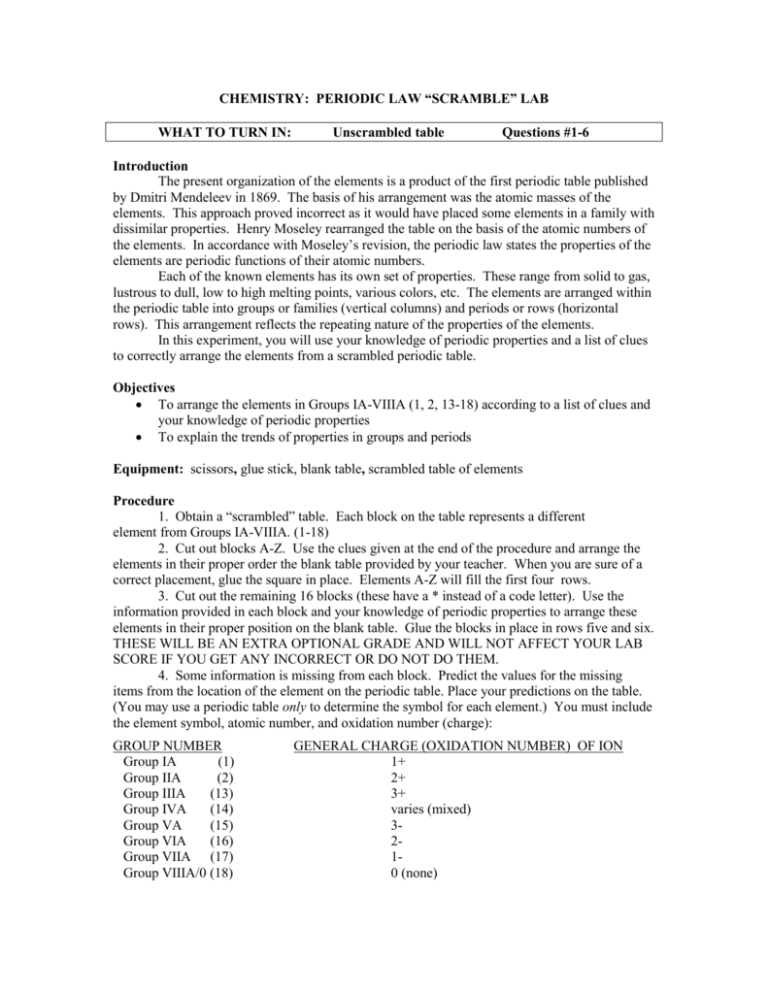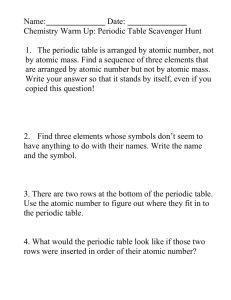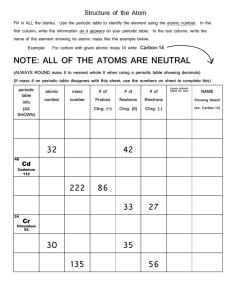Chemistry Periodic Table Scramble Lab Worksheet
advertisement

CHEMISTRY: PERIODIC LAW “SCRAMBLE” LAB WHAT TO TURN IN: Unscrambled table Questions #1-6 Introduction The present organization of the elements is a product of the first periodic table published by Dmitri Mendeleev in 1869. The basis of his arrangement was the atomic masses of the elements. This approach proved incorrect as it would have placed some elements in a family with dissimilar properties. Henry Moseley rearranged the table on the basis of the atomic numbers of the elements. In accordance with Moseley’s revision, the periodic law states the properties of the elements are periodic functions of their atomic numbers. Each of the known elements has its own set of properties. These range from solid to gas, lustrous to dull, low to high melting points, various colors, etc. The elements are arranged within the periodic table into groups or families (vertical columns) and periods or rows (horizontal rows). This arrangement reflects the repeating nature of the properties of the elements. In this experiment, you will use your knowledge of periodic properties and a list of clues to correctly arrange the elements from a scrambled periodic table. Objectives To arrange the elements in Groups IA-VIIIA (1, 2, 13-18) according to a list of clues and your knowledge of periodic properties To explain the trends of properties in groups and periods Equipment: scissors, glue stick, blank table, scrambled table of elements Procedure 1. Obtain a “scrambled” table. Each block on the table represents a different element from Groups IA-VIIIA. (1-18) 2. Cut out blocks A-Z. Use the clues given at the end of the procedure and arrange the elements in their proper order the blank table provided by your teacher. When you are sure of a correct placement, glue the square in place. Elements A-Z will fill the first four rows. 3. Cut out the remaining 16 blocks (these have a * instead of a code letter). Use the information provided in each block and your knowledge of periodic properties to arrange these elements in their proper position on the blank table. Glue the blocks in place in rows five and six. THESE WILL BE AN EXTRA OPTIONAL GRADE AND WILL NOT AFFECT YOUR LAB SCORE IF YOU GET ANY INCORRECT OR DO NOT DO THEM. 4. Some information is missing from each block. Predict the values for the missing items from the location of the element on the periodic table. Place your predictions on the table. (You may use a periodic table only to determine the symbol for each element.) You must include the element symbol, atomic number, and oxidation number (charge): GROUP NUMBER Group IA (1) Group IIA (2) Group IIIA (13) Group IVA (14) Group VA (15) Group VIA (16) Group VIIA (17) Group VIIIA/0 (18) GENERAL CHARGE (OXIDATION NUMBER) OF ION 1+ 2+ 3+ varies (mixed) 3210 (none) CLUES: The following sets of elements belong together in groups: ZRD PSIF JXBE LHT QKA WOV 1) 2) 3) 4) 5) 6) 7) 8) 9) 10) 11) 12) 13) 14) 15) 16) 17) 18) 19) 20) 21) 22) 23) GNU YMC J has an atomic number three times that of T U has a total of six electrons. I2A is the simple formula of an oxide. Element A is what makes it an oxide. P is less dense than S. S is an alkali metal. E is a noble gas. W is a liquid. Z has the smallest atomic mass in its group. B has ten protons. O has an atomic number larger than V. D has the largest atomic mass of its group. C has five electrons in its outer energy level. F is a gas. X has an atomic number one higher than F. L is an alkaline earth element with atomic mass approximately equal to 40. Y is a metalloid. O is a halogen. The atomic mass of T is more than that of H. Q has an atomic mass 2 times that of A. Atoms of I are larger than those of S. M has an atomic number one less than that of A. The electrons of atom N are distributed over three energy levels. The atomic radius of K is the largest of the group. Questions 1) Was this lab easier or harder than you expected it to be? Why? 2) The transition elements are missing from the abbreviated periodic table in this lab. Why do you think they were not included? 3) What is periodicity? How does it apply to this lab? 4) List three physical properties which distinguish metals from nonmetals. 5) Give a reason for the location of sodium in the periodic table. 6) How can an atom’s reactivity be predicted on the basis of its location in the periodic table?







